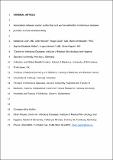Files in this item
Association between women's authorship and women's editorship in infectious diseases journals : a cross-sectional study
Item metadata
| dc.contributor.author | Last, Katharina | |
| dc.contributor.author | Hübsch, Lilith | |
| dc.contributor.author | Cevik, Muge | |
| dc.contributor.author | Wolkewitz, Martin | |
| dc.contributor.author | Müller, Sophie Elisabeth | |
| dc.contributor.author | Huttner, Angela | |
| dc.contributor.author | Papan, Cihan | |
| dc.date.accessioned | 2022-09-09T11:30:15Z | |
| dc.date.available | 2022-09-09T11:30:15Z | |
| dc.date.issued | 2022-10-01 | |
| dc.identifier | 280831355 | |
| dc.identifier | 07674b62-44e6-476b-ae26-21aab9c50db8 | |
| dc.identifier | 35839790 | |
| dc.identifier | 85138549696 | |
| dc.identifier | 000898530100034 | |
| dc.identifier.citation | Last , K , Hübsch , L , Cevik , M , Wolkewitz , M , Müller , S E , Huttner , A & Papan , C 2022 , ' Association between women's authorship and women's editorship in infectious diseases journals : a cross-sectional study ' , Lancet Infectious Diseases , vol. 22 , no. 10 , pp. 1455-1464 . https://doi.org/10.1016/S1473-3099(22)00367-X | en |
| dc.identifier.issn | 1473-3099 | |
| dc.identifier.other | Jisc: 487372 | |
| dc.identifier.other | pii: S1473-3099(22)00367-X | |
| dc.identifier.other | ORCID: /0000-0003-1133-3874/work/117212007 | |
| dc.identifier.uri | https://hdl.handle.net/10023/25985 | |
| dc.description | Funding: This study has been funded by a 2021 CAREer Grant from the European Society of Clinical Microbiology and Infectious Diseases (ESCMID) to CP. | en |
| dc.description.abstract | Background Gender inequity is still pervasive in academic medicine, including journal publishing. We aimed to ascertain the proportion of women among first and last authors and editors in infectious diseases journals and assess the association between women's editorship and women's authorship while controlling for a journal's impact factor. Methods In this cross-sectional study, we randomly selected 40 infectious diseases journals (ten from each 2020 impact factor quartile), 20 obstetrics and gynaecology journals (five from each 2020 impact factor quartile), and 20 cardiology journals (five from each 2020 impact factor quartile) that were indexed in Journal Citation Reports, had an impact factor, had retrievable first and last author names, and had the name of more than one editor listed. We retrieved the names of the first and last authors of all citable articles published by the journals in 2018 and 2019 that counted towards their 2020 impact factor and collected the names of all the journals' editors-in-chief, deputy editors, section editors, and associate editors for the years 2018 and 2019. We used genderize.io to predict the gender of each first author, last author, and editor. The outcomes of interest were the proportions of women first authors and women last authors. We assessed the association between women's editorship and women's authorship by fitting quasi-Poisson regression models comprising the variables: the proportion of women last authors or women first authors; the proportion of women editors; the presence of a woman editor-in-chief; and journal 2020 impact factor. Findings We found 11 027 citable infectious diseases articles, of which 167 (1·5%) had an indeterminable first author gender, 155 (1·4%) had an indeterminable last author gender, and seven (0·1%) had no authors indexed. 5350 (49·3%) of 10 853 first authors whose gender could be determined were predicted to be women and 5503 (50·7%) were predicted to be men. Women accounted for 3788 (34·9%) of 10 865 last authors whose gender could be determined and men accounted for 7077 (65·1%). Of 577 infectious diseases journal editors, 190 (32·9%) were predicted to be women and 387 (67·1%) were predicted to be men. Of the 40 infectious diseases journals, 13 (32·5%) had a woman as editor-in-chief. For infectious diseases journals, the proportion of women editors had a significant effect on women's first authorship (incidence rate ratio 1·32, 95% CI 1·06–1·63; p=0·012) and women's last authorship (1·92, 1·45–2·55; p<0·0001). The presence of a woman editor-in-chief, the proportion of women last or first authors, and the journal's impact factor exerted no effect in these analyses. Interpretation The proportion of women editors appears to influence the proportion of women last and first authors in the analysed infectious diseases journals. These findings might help to explain gender disparities observed in publishing in academic medicine and suggest a need for revised policies towards increasing women's representation among editors. | |
| dc.format.extent | 10 | |
| dc.format.extent | 197002 | |
| dc.language.iso | eng | |
| dc.relation.ispartof | Lancet Infectious Diseases | en |
| dc.subject | Gender disparity | en |
| dc.subject | Gender inequity | en |
| dc.subject | Gender inequality | en |
| dc.subject | Academic medicine | en |
| dc.subject | Publishing | en |
| dc.subject | Authorship | en |
| dc.subject | Editorship | en |
| dc.subject | Infectious diseases | en |
| dc.subject | H Social Sciences (General) | en |
| dc.subject | R Medicine (General) | en |
| dc.subject | 3rd-DAS | en |
| dc.subject | SDG 3 - Good Health and Well-being | en |
| dc.subject | SDG 5 - Gender Equality | en |
| dc.subject | AC | en |
| dc.subject | MCC | en |
| dc.subject.lcc | H1 | en |
| dc.subject.lcc | R1 | en |
| dc.title | Association between women's authorship and women's editorship in infectious diseases journals : a cross-sectional study | en |
| dc.type | Journal article | en |
| dc.contributor.institution | University of St Andrews. Infection and Global Health Division | en |
| dc.contributor.institution | University of St Andrews. School of Medicine | en |
| dc.identifier.doi | 10.1016/S1473-3099(22)00367-X | |
| dc.description.status | Peer reviewed | en |
This item appears in the following Collection(s)
Items in the St Andrews Research Repository are protected by copyright, with all rights reserved, unless otherwise indicated.

